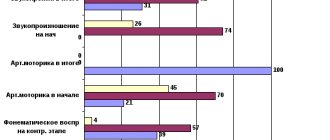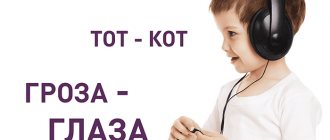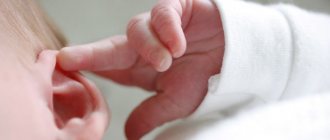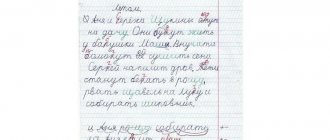The development of perception of the sound structure of speech is associated with the formation of phonemic hearing or phonemic perception in a child, which, according to many modern researchers, is the same thing, since specialists from different fields of knowledge study this issue.
Phonemic
analysis and synthesis
are
internal actions to analyze or synthesize the sound composition of a word . Teaching literacy in the Russian language is carried out using the analytical-synthetic method, therefore, in order to master reading and writing, a child must have a good understanding of the sound composition of words, that is, be fully proficient in phonemic analysis and synthesis.
Methods for diagnosing a child’s readiness for school involve testing phonemic processes along with thinking abilities and volitional qualities. Disturbances in the processes of phonemic recognition of sounds are the causes of dysgraphia, dyslexia, and dysorthography.
Phonemic analysis and synthesis in ontogenesis
A. N. Gvozdev believes that the function of the child’s auditory analyzer is formed early, much earlier than the speech motor analyzer. Already in the second week of life, the child, hearing the sounds of a voice, stops sucking; stops crying when people start talking to him. He early distinguishes the sounds of the human voice and responds to this stimulus, depending on the intonation, either with a smile or a cry.
From 6 months, by imitation, he pronounces individual phonemes, syllables, imitating tone, tempo, rhythm, melody and intonation.
By the age of 2, children begin to distinguish quasi-homonym words (paronyms). By this age, the formation of phonemic hearing ends, as evidenced by the child’s phonemic discrimination of all the sounds of his native language. He is able to distinguish words by sound that differ by one phoneme.
In the process of early speech development, expressive and impressive speech are closely related: on the one hand, speech development stimulates auditory perception, on the other hand, it clarifies one’s own pronunciation.
EXAMPLES OF EXERCISES
Games for the development of phonemic hearing are numerous and varied. Some examples of exercises:
- "Confusion". Task: clap your hands when pronouncing the word correctly. The child is shown a picture, for example, of a saucepan. First, the adult loudly and clearly pronounces the correct name (introduces it to the baby). Then he begins to deliberately distort: tastryulya, sastryulya, bastrulya, dastryulya. About halfway through, “pan” is pronounced correctly, and this point is indicated by a clap. Then the picture and word change.
- "Extra sound." Task: eliminate the extra syllable (word). An adult clearly pronounces: ta-ta-ta-da-ta, sa-za-sa-sa-sa, cat-cat-that-cat.
- "The sound got lost." Task: Understand what is wrong in the sentence and correct it. Example: in the spring, the lights (flowers) bloomed, oak trees (teeth) grew in the mouth, the puppy lives in a bun (kennel), the mother braided her kidney (daughter’s) braid.
- "Where is the sound?". Game for schoolchildren. Task: place the chip correctly on the card with the word. For example, an adult calls the sound “U”, and puts a card with the word “Dinner” in front of the child. The correct location of the chip is the first letter.
To develop phonemic awareness and hearing, it is useful for children to read age-appropriate books, speak competently and clearly in their presence, and use different intonations and volume of speech. Special attention should be paid to active cognition of the surrounding world, training visual, auditory, tactile and other analyzers.
Stages of speech perception
N.H. Shvachkin divides the process of speech perception into 2 stages:
- prephonemic (from birth to 1 year);
- phonemic (after one year, respectively).
Prephonemic stage. The child does not distinguish between phonemes and the sound-syllable structure of a word. At this stage, the child’s sound complex has several meanings. In other words, up to 1 year of age, the semantic load is carried not by the phoneme, but by the intonation, rhythm, and general sound pattern of the word. Moreover, up to 6 months, intonation plays a leading role, and at the 6th month, rhythm takes on a semantic orientation.
Phonemic stage. “Phonological development occurs rapidly, constantly ahead of the child’s articulatory capabilities, which serves as the basis for improving pronunciation.” Until this moment, the child recognized words by sound pattern, and from that moment he began to distinguish phonemes. First, contrasting ones, then complex ones, and lastly distinguishes between acoustically similar ones.
PROBABLE CAUSES
The development of phonemic hearing is influenced by the upbringing environment, the example of speech in the family, the state of the peripheral nervous system, etc.
Among the most likely causes of the violation are the following:
- pedagogical neglect;
- hearing loss;
- head injuries, hearing and speech pathologies;
- hyperactivity;
- weakening of the body, serious or frequent illnesses, especially at an early age;
- diseases of the thyroid gland and digestive organs;
- neurological disorders.
To identify the exact cause, it is necessary to consult an ENT specialist, neurologist and speech therapist as early as possible. Sometimes, in addition to the development of phonemic hearing, drug or surgical treatment is required: cutting the hypoglossal ligament, taking central nervous system stimulants.
Phonemic hearing is very important for the development of correct speech. It is necessary not to miss the moment and pay due attention to it at the age of 4–6, so that the child learns easily at school and does not face ridicule from his peers. It is better if the method of hearing development is developed individually, taking into account all the characteristics of the baby.
Phonemic series
N. Kh. Shvachkin identified 12 phonemic series according to the order of formation in children:
- The vowel “a”, all others are perceived as not “a”. Then the vowels are learned in opposition: “i” - “u”, “i” - “o”, “e” - “o”. Next, the child begins to distinguish close phonemes: “o” - “u”, “a” - “e”. The vowel “y” is the last one to learn.
- The presence or absence of consonants, as such. The child hears whether there is a consonant or not.
- Distinguishes between consonants along the line of sonority, that is, oral and nasal consonants. This is facilitated by the resonance of a particular cavity. That is, the child relies on tactile and vibration sensations and kinesthesia.
- Distinguishes consonants by hardness and softness. The interaction between hearing and articulation plays a big role.
- Distinguishes sonorant sounds “r” - “l”; noisy consonants “zh” - “sh” - “ch”.
- Distinguishes between labial "p" - "b" - "m" and lingual "t" - "d" - "n". Discrimination is aided by articulation and visual control.
- Sonorans among themselves: “m” - “n” - “r” - “l”.
- There are plosives: "b" - "p" - "m" - "t" - "d" - "n" - "k" - "g" and slotted "x" - "s" - "w" - "z " Moreover, plosive sounds begin to be articulated earlier and, on the basis of their pronunciation, fricative sounds begin to be distinguished, that is, plosives appear earlier, and on their basis fricatives.
- They begin to distinguish between the front and rear lingual “t” - “d” - “n”, “k” - “g” - “x”. This difference arises quite late, since it requires precise articulation and localization of the tongue at the place of formation.
- Distinguishes between voiceless and voiced consonants.
- Distinguish between whistling and hissing. Requires maximum perfection of hearing and subtle differentiated movements of the front of the tongue.
- Distinguishing between the sounds “r” - “l”.
Of all types of analysis of speech flow (dividing sentences into words, words into syllables, syllables into sounds), the most difficult is the phonemic analysis of words.
— From the age of 4, a child is able to distinguish a sound from the background of a word.
- From 5 years old - highlight the stressed vowel at the beginning of the word.
— From 6 years old:
1) determine the first consonant sound in a word (house, bun, etc.);
2) determine the last sound in the word (cheese);
3) determine the consonant in the middle;
4) determine the sequence of sounds in a word (poppy);
5) determine the number of sounds in a word.
Games for the development of phonemic awareness help the child in the development of phonemic analysis and synthesis. The child masters complete phonemic analysis in the process of learning to read and write. At school, a primer period is specially allocated for working on the analysis of speech flow.
By the end of preschool age, the child correctly hears every phoneme of the language. Does not mix it with other phonemes, masters their pronunciation.
DEVELOPMENT METHODS
It is possible to develop phonemic awareness only gradually. First, the child learns to recognize sounds that are not similar to each other, then learns about correct and incorrect pronunciation, and begins to find errors in familiar words. Next, the ability to conduct phonemic analysis, isolate sounds in parts of a word (beginning, middle, end), and select a rhyme is formed. At the final stage, already at school, the child can determine the quantitative sound composition of a word. He develops the ability to use test words and understand the rules.
The method of developing phonemic hearing is based on developing the ability to navigate the sound side of a word. Training is carried out in the form of a game and includes the following exercises:
- articulatory gymnastics aimed at improving the mobility of the tongue, lips, etc.;
- breathing exercises that allow you to correctly direct the air stream (for example, exercise “Candle”, “Feather”);
- education of intonation expressiveness of speech;
- developing the ability to control the power of the voice;
- classes on the correct pronunciation of all sounds;
- sound analysis of words (selection of similar and different-sounding words, identification of soft and hard sounds, ringing, murmuring, hissing, etc.);
- games with words (for example, choose a word that begins with a certain sound).
In this case, it is necessary to take into account the individual characteristics of the child, the upbringing environment, structural defects of the speech apparatus (short hyoid ligament, small and narrow tongue, open bite, etc.). Also, when developing phonemic hearing, one should take into account the sequence of distinguishing sounds - first vowels, then noisy and sonorant consonants, hard and soft, labial - lingual, deaf - voiced, hissing - whistling.
Formation of auditory control
L. E. Zhurova believes that children of primary preschool age are able to identify the first and last sound in a word, and children of middle preschool age can easily cope with this task. When analyzing the sound composition, the child begins to pronounce it in a special way with intonation highlighting the sound, which must then be named separately.
At the age of 3–7 years, the skill of auditory control over one’s pronunciation develops.
M.E. Khvattsev believes that phonemic hearing develops in unity with the articulation of sound.
With sufficient mental and speech development, phonemic perception is sufficiently formed already in preschool age. The process of phonemic analysis is a more complex function and is formed in children at later stages of speech development.
Phonemic analysis is a complex mental process. Readiness for sound analysis is acquired in the process of developing oral speech throughout preschool age.
Practical ideas about the sound composition of a language are formed on the basis of phonemic analysis and perception. Memory and attention play a significant role in this process.
A number of authors note that the formation of impressive speech is a complex process in which the following patterns are noted: from the perception and memorization of individual words and phrases to the formation of complex phonemic hearing and, on its basis, sound analysis, thanks to which a person masters written speech.
AT WHAT AGE SHOULD I START CLASSES?
The process of developing phonemic hearing in children is individual. It happens that a child begins to perfectly catch sounds and speak at 1.5–2 years. But more often, active formation occurs at the age of 4 years and continues until 5–6 years. At the same time, the most sensitive and significant period of development remains the first years of life.
If up to 2 years of age you talk to your child correctly, without babying, read poems that he understands, and learn simple phrases, then the risk of phonemic hearing disorders decreases significantly. In other words, classes can be conducted from a very early preschool age. There are a lot of exercises and games for the development of phonemic hearing in children 1 year old, 2-3 years old and older. In each case, tasks are selected that correspond to the child’s capabilities.
Important. The optimal time for the development of phonemic hearing is preschool age. Further solving existing problems will become increasingly difficult, and after 9 years it will be almost impossible.
conclusions
Thus, the following conclusions can be drawn:
- The function of the child’s auditory analyzer is formed early, much earlier than the speech motor analyzer.
- Phonemic hearing consists of the ability to generalize different sounds into separate groups, to combine sounds, taking as a basis some essential features and ignoring other, random features.
- The process of speech perception is divided into two stages: prephonemic and phonemic.
- N. Kh. Shvachkin identifies 12 phonemic series according to the order of formation in children.
- Of all types of analysis of speech flow (dividing sentences into words, words into syllables, syllables into sounds), the most difficult is the phonemic analysis of words.
- Practical ideas about the sound composition of a language are formed on the basis of phonemic analysis and perception. Memory and attention play a significant role in this process.
Korchagina Larisa, teacher-speech therapist (St. Petersburg)
How to develop phonemic hearing in children with ODD. Consultations for parents.
GBDOU d/s No. 15 of a compensating type in the Petrogradsky district of St. Petersburg. Speech therapist teacher: Kuzmenko L.N.
Phonemic hearing is a person’s ability to analyze and synthesize speech sounds, i.e. hearing, which provides the perception of phonemes of a given language. "Speech therapist's dictionary" ed. IN AND. Seliverstova.
Most parents believe that it is enough to teach their child the letters, and he will begin to read and write correctly. But this is a big misconception!
Practice shows that knowledge of letters does not exclude serious difficulties for schoolchildren when learning to read and write. How much the child worries about the mistakes corrected by the teacher’s red pen! How boring it is to do “Work on mistakes”!
The main cause of errors is impaired phonemic hearing, i.e. ability to distinguish and isolate speech sounds. In order to write correctly, the child needs to imagine that a sentence consists of words, words of sounds, and the sounds in a word are located in a certain sequence. Therefore, it is important to develop phonemic hearing in a child!
Let's get started! Classes should not be boring lessons, but an interesting game. After all, play, being the leading activity of preschool age, allows you to make the learning process accessible and interesting. Our classes will be held in a playful form, but will be educational in nature. In essence, they are “Working on errors”, preventing their occurrence. This kind of “Work on mistakes” is fun to do, and when you come to school, your child will write a dictation without mistakes.
Scientists have proven that even before birth, children hear and react to sounds from the outside world in different ways.
With the birth of a child, these sounds fill his world: the singing of birds and the murmur of water, the sound of the wind and the rustling of leaves. The baby begins to listen to surrounding sounds. But words—speech sounds—are the most significant from his birth. Sounded speech provides the necessary communication and information acquisition for the child.
By listening to words, comparing their sounds and trying to repeat them, the child begins not only to hear, but also to distinguish the sounds of his native language. This ability develops in him gradually. From 2-4 weeks from birth, the baby begins to respond to any sounds. Melodious sounds make him feel satisfied and smile, and sharp sounds (angry voice) make him cry. At 7-10 months the child already responds to the word. Only towards the end of the first year of life does the word first begin to serve as an instrument of communication.
Further, phonemic development occurs rapidly, constantly ahead of the child’s pronunciation capabilities. Already in the third year of life, children can notice incorrect pronunciation among their peers and even try to correct them.
And by the age of 5, a child develops a critical attitude not only to someone else’s speech, but also to his own speech. He is very sensitive to the inaccuracies of his pronunciation, which manifests itself in his refusal to communicate and to collaborate together. In addition, this necessarily affects the mastery of reading and writing.
Correcting pronunciation deficiencies in children involves producing sounds and introducing them into speech while simultaneously developing phonemic hearing. Without a full perception of sounds, without their clear distinction, the formation of pure speech is impossible.
But, if a child pronounces all the sounds correctly, he often does not distinguish some of them by ear, and this, in turn, greatly complicates and sometimes distorts the understanding of speech, and also manifests itself in errors when writing.
It is much easier to prevent a violation than to correct it. This means that work on developing phonemic awareness prepares children to master correct pronunciation and is aimed at preventing grammatical errors.
First of all, find out how the baby perceives and distinguishes sounds. The following simple tasks will help with this: 1. Offer to repeat after you the syllables: sa-sha, sha-sa, sa-tsa, ach-ashch, ra-la, sha-zha. If a child pronounces some sounds incorrectly, discrimination is checked as follows: ask him to perform some action after hearing a given syllable. For example, if among the syllables sa, tsa, cha, the syllable sha is called, the child claps his hands. 2. Let’s check whether the child distinguishes words that are similar in sound but different in meaning.
- Invite him to choose the desired picture among: beetle-bitch, house-catfish, bowl-mouse, goat-braid, puddle-ski.
- Explain the meaning of the words: “What is a puddle and what is a ski?”
3. The following technique will reveal the degree of development of attention and auditory memory.
- Invite your child to repeat similar syllables: ta-da-ta, ka-ga-ga, pa-ba-ba, ma-na-ma.
- Repeat similar words: Masha-Dasha-porridge; shadow-day; day-stump; lac-mac-crayfish; beetle-bow suk-knock.
Difficulties in completing tasks indicate a decrease in phonemic awareness.
Work on the development of phonemic perception begins with the material of non-speech sounds and, gradually, covers all speech sounds. The tasks are offered in strict sequence, conditionally divided into six stages:
- recognition of non-speech sounds;
- distinguishing the height, strength, timbre of the voice, based on the same sounds, combinations of words and phrases;
- distinguishing words that are similar in sound composition;
- syllable discrimination;
- distinguishing sounds;
- analysis of the sound composition of a word.
Let's get started on developing your baby's phonemic awareness!
Stage 1 – recognition of non-speech sounds.
The goal of the first stage is the development of auditory attention and auditory memory, which is especially important for the successful development of phonemic perception in general. The inability to listen attentively to the speech of others is often one of the reasons for incorrect pronunciation, so it is necessary to teach the child to hear sounds and be able to compare them.
Let's look at what games and exercises can be done with children at the first stage of work.
- Invite your child to listen to the sounds outside the window: “Close your eyes and listen!” What's making noise? What's buzzing? Who's screaming? Who's laughing?"
- Use the following games:
Game "Sun or Rain?"
Today we will go for a walk. There is no rain. The weather is good, the sun is shining, and you can pick flowers. You go for a walk, and I will ring the tambourine. Let's have fun walking to these sounds. If it starts to rain, I'll start banging on the tambourine. And when you hear the knock, you should run under your umbrella. Listen carefully!
The game “Sun and Rain” is quite simple, however, children really like it and it’s always fun!
Game "Big or Small".
Place two toy hares (bears, dolls) on the table - a large one and a small one. Explain and show how the big hare, who has a lot of strength, plays the drum loudly, and the little one plays quietly. Then cover the toys with a screen and behind it make loud and then quiet beats on the drum. The kid must find out and show which of the hares just played.
Such games should be played with children starting from 2-3 years old. But, even if the kids are older, and you have discovered a decrease in phonemic hearing, you should also start working with these games. Because only gradually increasing the complexity of tasks will achieve maximum efficiency.
Stage 2 – distinguishing the height, strength, timbre of the voice.
At this stage, it is necessary to teach the child to understand the intonation of speech and to master the means by which the emotional shades of speech are expressed.
Game "Far - Close".
The game is aimed at developing the basic qualities of the voice: strength, height.
An adult shows the child a toy kitten and asks him to listen carefully and remember how it meows when it is close (loud), and how it meows when it is far away (quiet).
Then he says “Meow”, changing the strength of his voice, and the baby guesses whether the kitten is meowing close or far away.
Then the baby himself meows at the adult’s signal: “far” - “close”.
A further complication of the game is that the child will distinguish between meows, focusing on the timbre and individual characteristics of the speaker’s voice. The adult explains that the kitten is very afraid of the puppy and meows pitifully, trembling with fear. The child should meow, feigning fear.
Similarly, you can play by distinguishing where the steamer is humming (oooh) - far away (quietly) or close (loudly); what kind of pipe is playing - a large one (“oo-oo-oo” pronounced in a low voice) or a small one (“oo-oo-oo” pronounced in a high voice); who is crying - a boy (“a-a-a” in a low voice) or a girl (“a-a-a” in a high voice).
In addition, at this stage it is important to teach the child to determine the tempo of speech by ear. Games for performing movements at an appropriate pace will help with this.
Game "Guess what to do."
An adult pronounces the phrase: “The mill grinds grain” several times at different tempos. Children, imitating the operation of a mill, should make circular movements with their hands at the same pace at which the adult speaks. You can also play on other phrases: (“Our feet walked along the road”) or even poetry:
A drop once, a drop two, A drop slowly at first - Drip, drip, drip, drip. (slow clapping) The drops began to keep up. Drop drop catch up - Drip, drip, drip, drip (pop more often). Let’s quickly open the umbrella and protect ourselves from the rain (hands above our heads).
Use dramatization.
An adult tells the fairy tale “The Three Bears”, accompanying his speech with illustrations. Pronouncing remarks either very low, then medium in pitch, then in a high voice he asks: “Who is saying this?” The kid guesses the bears.
Ask, for example: “What did Bear say when he saw his chair moved?”
The baby, answering questions, changes the pitch of his voice accordingly. An adult must ensure that, imitating Mishutka, Ursa and the Bear, the child does not speak very high (to the point of squeaking) and very low (to the point of hoarseness in his voice), i.e. to raise and lower his voice within the limits available to him.
You can dramatize this tale with older children.
When playing with a 2-4 year old child, the adult directs the course of the game, taking on the role of the leader. Children 5-7 years old, having learned the rules of the game, can play independently.
Stage 3 – distinguishing words that are similar in syllabic composition.
A child’s mastery of speech is associated with his increased interest in the sound of the word. By the end of the second year of life, the baby becomes a real inventor, composing entire songs consisting of a set of different sounds and words that are similar in sound. He listens to their combination, enjoying the sound. Thus, the child carries out a lot of mental work on the sound side of the word.
Let's take advantage of each child's natural talent for rhyming words.
Game "Don't make a mistake."
An adult shows a picture and loudly and clearly calls the image: “Paper.” Then he explains: “I will name this picture either correctly or incorrectly, and you listen carefully. When I make a mistake, clap your hands." Then he says: “Paper - pumaga - tumaga - pumaka - paper.” The game is interesting to children and they always respond happily to it.
It must be emphasized that you need to start with simple words and sound composition, gradually moving on to more complex ones.
You can use poems to include the missing word, which develops a sense of rhythm and rhyme in children, helps expand their vocabulary, and improves the child’s phonemic awareness.
— In Africa we will find coconut and (pineapple) more than once. — Brooches and hairpins are arguing: who has the sharper ones (needles).
Stage 4 – distinguishing syllables.
A syllable is the minimal unit of speech flow. For games on distinguishing syllables, it is good to use onomatopoeia.
The game “Who is screaming?” An adult puts up pictures and says: “Look at the pictures, listen to who screams and repeat.”
- Another version of the game: pictures for the child. The adult names the syllables, and the baby picks up the corresponding picture.
Stage 5 – distinguishing sounds
In any language there is a certain number of sounds that create the sound appearance of a word. Sound outside speech has no meaning; it acquires it only in the structure of the word, helping to distinguish one word from another (dom, som, com). This sound is called a phoneme (hence “phonemic hearing”). Everyone remembers such characteristics as consonant and vowel sounds. You need to start by distinguishing vowel sounds.
— An adult gives pictures to the child Pictures of a train, a girl, a bird and explains: “The train is buzzing oo-oo-oo; the girl is crying ah-ah-ah; the bird sings and-and-and-and.” Next, he pronounces each sound for a long time, and the child picks up the corresponding picture.
Work on distinguishing consonant sounds is carried out in a similar way.
Game "Bike Ride".
— The adult says: “Now we’re going to go riding bicycles. Let's check if the tires are well inflated. Let's pump it up again: sssss... (Children imitate). Hear the air hissing: shhhh..." - Be careful, if I show a picture of a pump, you should say: “ssss,” and if with a picture of a tire: “shhhh.”
The game “Bug and Mosquito” is played in a similar way (sounds C and F).
Stage 6 – analysis of the sound composition of the word.
The term “phonemic (sound) analysis” defines both elementary and complex forms of sound analysis. Elementary is the selection of sound against the background of a word. Isolating the first and last sound from a word and determining its place (beginning, middle or end of the word) refers to a complex form. The most difficult sound analysis is determining the sequence of sounds in a word. Complex forms arise only during the learning process, and even then, only after the child has mastered the skills of elementary analysis of the sound composition of a word.
- Children hear and identify the stressed vowel at the beginning of a word best: Name the first sound in the word Beehive, Stork, Ira, Olya.
- Give the child several identical circles. An adult pronounces one, two, three vowel sounds: a, ay, aui. The child places as many circles on the table as the sounds the adult makes.
Game “We’ll let a set of special words into the yard.”
The adult invites the children to depict a closed gate: palms turned towards the face, connect the middle fingers, raise the thumbs up: “We will “let through” only words with a given sound into the yard.” Kids open the gate if they hear a given sound. If the word does not contain the specified sound, then the gate slams. At the end, you can invite the children to remember all the words that they “missed into the yard.”
Let's start analyzing consonant sounds. In this case, the sequence must be observed: first, they are taught to highlight the last consonant sound in a word.
Select the pictures so that the word ends with a consonant sound and put it in an envelope. The child takes out the pictures one at a time, names them loudly, highlighting the last sound. Then the baby names the sound separately (beetle, onion, cat).
Game “Don’t touch the ball or catch it – try to guess”
The adult invites the child to catch the ball if he hears a given sound at the end of a word, or to hide his hands behind his back if there is no given sound.
Only after the baby learns to easily perform such tasks can one move on to complex forms of sound analysis: this is determining the place of a sound in a word (beginning, middle, end), determining the sequence of sounds in a word, their number.
The experience your children will gain will make their schooling much easier. And you didn’t have to set up some kind of school at home. We played! And in the game, even the complex becomes accessible. The most important thing is to believe in your child and help him understand the world of sounds!
Used literature: Kunichenko O.A. “Development of phonemic hearing”, Tkachenko T.A. “Development of phonemic perception and sound analysis skills”, Boryakova N.Yu., Kositsina M.A. “Correctional and pedagogical work in kindergarten for children with special needs development.” Program for the education and training of preschool children with mental retardation, ed. Boryaeva L.B. and Loginova E.A.


![Hard and soft sound [d]](https://ls-kstovo.ru/wp-content/uploads/tverdyj-i-myagkij-zvuk-d3-330x140.jpg)



